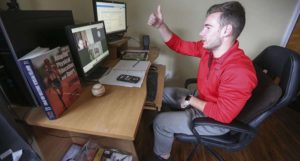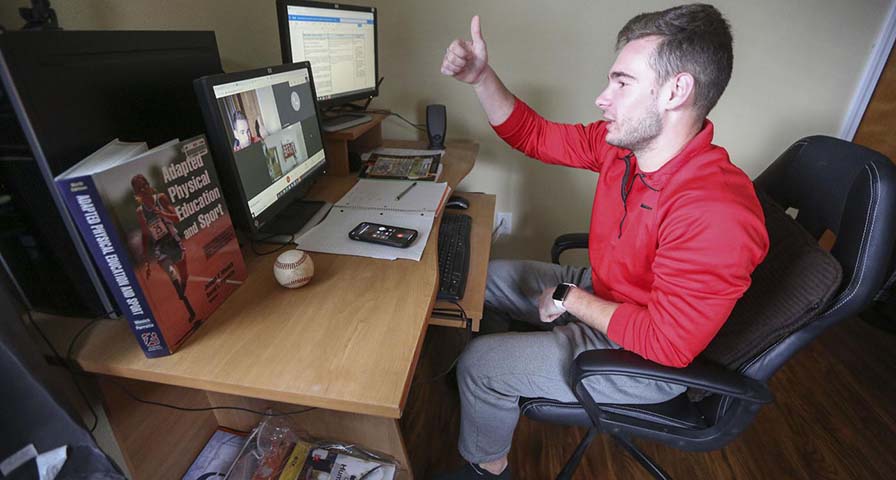Originally published April 24, 2021 in the Telegraph Herald.
By Bennet Goldstein
An 8-year-old girl appeared in a blurry video feed, rising from the bottom of the screen like a sunrise.
First, her yellow bow crept into the frame, then the glasses that rested lopsided across the bridge of her nose. Below her drooping face mask, Dahlia Chapin smiled.
“Do you have one thing that you learned today during the lesson, Dahlia?” asked her teacher, Chris Carr.

Chris Carr gives a thumbs-up to a second grade student during an adapted PE class he teaches from his home. Photo by Dave Kettering, Telegraph Herald
“What?” the second-grader asked, still crouching beside the computer.
“Do you have one thing that you learned?”
Carr’s image froze on Dahlia’s computer screen.
“What?” she asked. “I can’t even hear you.”
The connection dropped between Carr’s computer in Platteville and a laptop 130 miles away at Franklin Elementary School in Oshkosh.
A University of Wisconsin-Platteville senior, Carr has spent the semester remotely co-instructing adapted physical education classes for students with disabilities. With the onset of the COVID-19 pandemic, UW-P administrators decided that education students would not enter school buildings, even those who need to teach to complete their degree. Carr and five of his classmates were left to grapple with the question of how to teach physical education when they cannot be physically present. They fashioned a virtual alternative.
“Obviously, it’s not ideal because you want to be in the gym with the kids, being able to demonstrate,” he said. “It definitely is something that takes getting used to.”
Carr hopes to become a PE teacher or attend graduate school and believes remote instruction will persist after the pandemic subsides. His semester teaching from his bedroom has become a primer in classroom management.
“I see you’ve got a bunny on your shirt,” he told Dahlia. “Can you show me how a bunny hops?”
The sound of her excitedly clopping on the tile floor echoed down the elementary school hallway.
“There you go,” Carr said. “Get the knees up if you can. Good job, Dahlia.”
Carr spent about two hours planning the morning lesson under the tutelage of Korey Kleinhans, an adapted physical education specialist with the Oshkosh Area School District. Kleinhans has supervised college students for three years.
The remote arrangement “really kept me on my toes with time management and communication with the college students,” he said.
Kleinhans works with Dahlia regularly and guided her as Carr ran through drills.
“Korey, with the camera, it’s going to be tough for me to demonstrate,” Carr said as Dahlia readied to toss beanbags into a hula hoop laid on the floor. “Can you demonstrate an underhand throw for me?”
Tim Swenson, an assistant professor in health and human performance, oversees Carr’s practicum class. He used the pandemic as an opportunity to pair UW-P students with PE teachers who work at schools outside of southwest Wisconsin, with such locations as Sun Prairie, Wis., Bloomfield, Mich., and Chicago.
Federal law requires that physical education be provided to students with certain disabilities as a component of special-education services. The curriculum is adapted to the student’s needs to enable his or her participation to the greatest extent possible.
“It’s very, very dependent on the unique needs of the student,” said Doug Bradley, a physical education teacher in the School District of Shullsburg who also supervises UW-P students.
Aside from the occasional technology hiccups, Carr has to compete for his pupils’ attention, particularly if they are learning from home.
Sometimes, students forget to turn on their cameras while videoconferencing. Occasionally, they have a hard time listening to directions.
But Carr, a high school athlete and avowed sports junkie from Darlington, said that he is not discouraged.
“The challenge aspect of it is very rewarding for me … working with them a little more, giving them that extra help so they can have their own success,” he said. “Students that maybe aren’t the most natural leaders, sports can bring out those leadership traits.”
Dahlia practiced her overhead throws by pummeling bowling pins with a yarn ball, a Wiffle ball and a gator skin ball.
“Oh, a little too high,” Carr said after she nearly struck home.
A couple more tosses and he noted her improved form.
“It was easy,” Dahlia said, pleased.
The girl performed another round of side-shuffles and then collapsed before the laptop in a heap.
“I’m tired,” she said. “Guess what? Today … I’m going to play with my new hula hoop.”
But Dahlia recalled how the presence of ice on the ground earlier this year had spoiled her plans.
“Wait, it’s melted already!” she said.
“It is melted,” Carr said. “It’s not that cold out, Dahlia.”
He did not get a response.
“It looks like it might be cutting out again,” Carr said.
Learn How the IHT Spirit System Encourages Students to Be Active:




